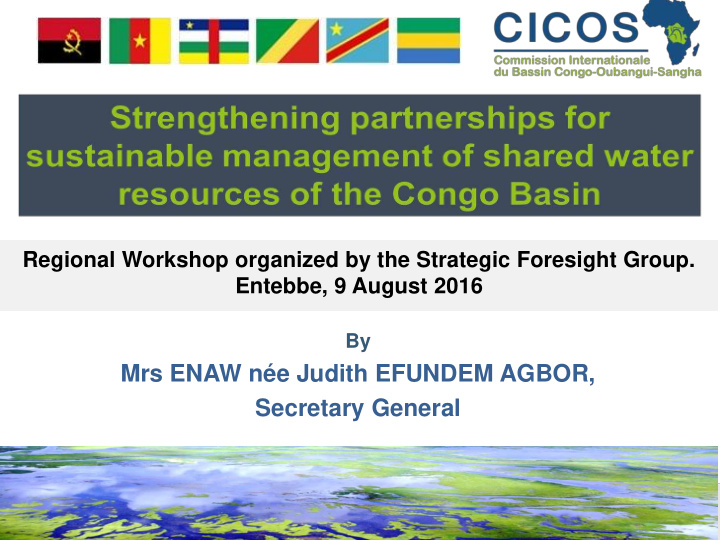



Regional Workshop organized by the Strategic Foresight Group. Entebbe, 9 August 2016 By Mrs ENAW née Judith EFUNDEM AGBOR, Secretary General
Presentation Outline • Key characteristics of the Congo Basin • CICOS: Governance Framework • CICOS: Financing Mechanism • Common Vision – 2035 • Basin Development Strategies • Other Ongoing Projects • Major Challenges • Conclusion 2
Key Basin Characteristics. The Basin covers an estimated area of 3,7 millions km²; Has an average annual discharge: of 41 000 m 3 /s; The basin straddles ten (10) countries: Angola, Burundi, Cameroon, Central African Republic, Republic of Congo, Democratic Republic of Congo, Gabon, Rwanda, Tanzania and Zambia. 3
Key Basin Characteristics (cont’d). Six (6) countries are members of the Commission; i.e Angola, Cameroon, Central African Republic, Congo, Democratic Republic of Congo, and Gabon; Thus, the Congo Basin is often referred to as “earth’s second lung” after the Amazon Basin Its water resources is a key driver for socio-economic development: - e.g. inland navigation, hydropower, eco-tourism, food production, etc. 4
CICOS: Governance Framework CICOS is an intergovernmental Organisation charged with the promotion of inland waterway navigation and the Integrated Management of Water Resources (IMWR) in the Congo basin. Legal Framework : Accord (1999) and its Additif (2007) Organs : • Ministerial Council (Decision making organ) • Management Committee (Consultative body) • General Secretariat : (Executing organ) Headquarters : Democratic Republic of Congo (Kinshasa) 5
CICOS : Financing Mechanism 2 Levels of financing a) CEMAC Funding • CICOS is a Specialized Institution of the Economic and Monetary Commission of Central African States (CEMAC) ; • The Heads of State of the CEMAC Region adopted the system of autonomous funding through the Community Integration Tax. b) Direct Funding • By the DRC and Angola - Contribute directly to CICOS through State Treasury 6
Common Vision: 2035 By 2035, the Congo basin will Pillars of SUSTAINABILITY be an example of regional integration , united where SOCIETY ECONOMY and emergent nations develop Basic needs linked to health, Wealth creation, Ameliorate education, habitat (housing) quality of life their capacities in order to employment, equity, social and Equity inter generation inclusion are make water a key driver for satisfied growth economic and a Sustainability source of wellbeing , while Viable preserving the quality of Dependable ecosystems as well as ENVIRONMENT adapting its uses to climate Conservation of biodiversity, natural change and encouraging cost resources and energy and benefit sharing . 7
Basin Development Strategies – GIZ Programme (GETRACO) • GIZ has supported CICOS in reforming its strategy through the formulation of a Water Master Plan (SDAGE) for the basin. • Participatory approach - involving multi-level stakeholders was used in the formulation of the SDAGE. • The participatory approach has set the impulse for collaboration and building of trust for the management of the shared resources of the basin. 8
Basin Development Strategies (cont’d ) MESA • EU through AU is supporting CICOS to access Earth Observation (EO) data and technologies under the Monitoring for Environment and Security in Africa (MESA) programme. • CICOS is using MESA to deepen the mechanism for information sharing with riparian Governments Institutions, industry (shipowners) – by providing real-time EO information on water depth to aid navigation; water balance to enhance decision making in water allocation and climate risk assessment. • The improvement in information sharing has provided platform for sustainable transboundary waters management 9
Main Ongoing Projects • AFD through the International Water Organization (l’ OIEau), is supporting CICOS to strengthen hydrological monitoring for IWRM in the basin, taking into account climate change adaptation; • Creating the Regional Observatory on inland waterway navigation mal practice (Financed by the European Union); • Organization of a Donor’s Round Table. 10
Major Challenges • Limited harmonization of legal frameworks for the management of water and other natural resources of the basin; • Population growth; • Deforestation; • Vulnerability to Climate Change; • Paucity of data for planning; • Low involvement of stakeholders; • Inadequate finances for project realization. 11
Conclusion Through these projects, CICOS is on the path to : • Promote better synergy among the various users of water resources in the Congo basin (i.e. inland waterway navigation, hydroelectricity provision, agriculture, fisheries, eco-tourism, etc.); • Guarantee the preservation of the natural heritage found within the basin; • Prevent and forestall potential conflicts which may arise from the use of transboundary water resources and from climate change; • Be an effective tool for water diplomacy in the Sub Region. 12
Thank you for your kind attention www.cicos.int. 1-2-3-4 13
Recommend
More recommend